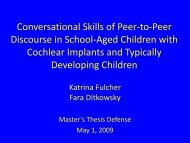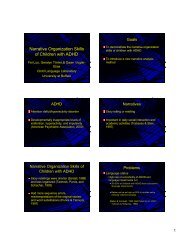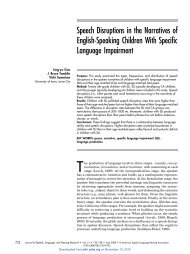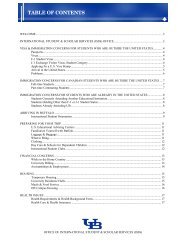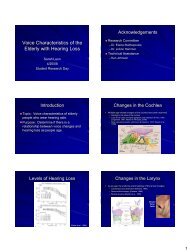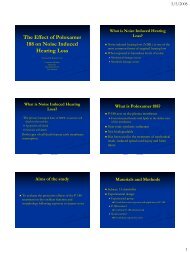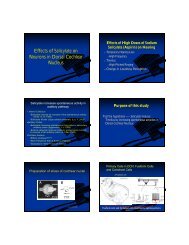Chronic Aphasia: Life After Treatment
Chronic Aphasia: Life After Treatment
Chronic Aphasia: Life After Treatment
Create successful ePaper yourself
Turn your PDF publications into a flip-book with our unique Google optimized e-Paper software.
<strong>Chronic</strong> <strong>Aphasia</strong>: <strong>Life</strong><br />
<strong>After</strong> <strong>Treatment</strong><br />
Carrie-Anne Kirkland, Ms. Ed.<br />
Doctoral Student<br />
Outline of Presentation<br />
1. Present general background on<br />
stroke and aphasia<br />
2. Discuss the effectiveness of therapy<br />
methods for acute and chronic PWA<br />
and their caregivers<br />
3. Identify some unanswered questions<br />
regarding the communication needs<br />
of PWA and their caregivers<br />
Statistics Cont’d<br />
� Medical advances have made survival<br />
from stroke more possible (Wineburgh &<br />
Small, 2004)<br />
� Stroke survivors live to an average age<br />
of 79.6 years (Circulation, 2006)<br />
Doctoral Committee Members<br />
� Rosemary Lubinski, Ed.D.<br />
� Kris Tjaden, Ph.D.<br />
� Geralyn Timler, Ph.D.<br />
Statistics<br />
� Stroke: 3 rd leading cause of death in the<br />
U.S. (Centers for Disease Control, 2008)<br />
� ~700,000 people incur a new or recurrent<br />
stroke each year (Circulation, 2006)<br />
Statistics Cont’d<br />
� At least 25% of all strokes result in<br />
aphasia<br />
(http://www.stroke.org/site/News2?page=NewsArticle&id=7121)<br />
� ~1 million PWA in the U.S. (National Stroke<br />
Association, 2008)<br />
5/5/2008<br />
1
Statistics Cont’d<br />
� ~80,000 new aphasia cases each year<br />
(National Stroke Association, 2008)<br />
� Of new cases reported each year 40%<br />
to 60% move from acute to chronic<br />
stage (Meinzer, Streiftau, & Rockstroh, 2007) 0<br />
Acute & <strong>Chronic</strong><br />
<strong>Aphasia</strong> Defined<br />
� Acute aphasia: First 6 months to 1 year<br />
post-stroke (Meinzer, Streiftau, & Rockstroh, 2007; Meinzer, et.<br />
Al., 2005)<br />
� <strong>Chronic</strong> aphasia: 6+ months (Eldar, 2000);<br />
2+ years post-stroke (Lyon, 1998)<br />
Therapy<br />
Acute Stage<br />
� Most rehabilitation occurs within the first 6<br />
months to 1 year post stroke<br />
� Medicare covers rehabilitation for up to<br />
two months (Holland & Fridriksson, 2001)<br />
� Other managed care organizations may<br />
limit services even more (Helm-Estabrooks & Holland,<br />
1998)<br />
Stroke<br />
<strong>Aphasia</strong><br />
Muscular<br />
Dystrophy<br />
Parkinson's<br />
Alzheimer's<br />
Disease<br />
1,000,000<br />
2,000,000<br />
3,000,000<br />
4,000,000<br />
5,000,000<br />
6,000,000<br />
New Cases each Year<br />
Current Cases in<br />
Millions<br />
Adapted from:<br />
Holland, A., Fromm, D., DeRuyter, F., & Stein, M. (1996). <strong>Treatment</strong> Efficacy: <strong>Aphasia</strong>. Journal of Speech and<br />
Hearing Research, 39: s27-s36.<br />
Lyden, P. (1996). Magnitude of the problem of stroke and the significance of acute intervention. Proceedings of a National<br />
Symposium on Rapid Identification and <strong>Treatment</strong> of Acute Stroke, Bethesda, MD.<br />
http://www.wrongdiagnosis.com/d/duchennemd/prevalence.htm<br />
http://www.cdc.gov/stroke/faqs.htm<br />
Factors Affecting<br />
<strong>Aphasia</strong> Therapy Today<br />
� Changes in health care policy<br />
� Insurance reimbursement<br />
� Federal health care legislation<br />
� Political climates<br />
� Managed health care/private insurance<br />
carriers<br />
Hallowell & Chapey, (2008)<br />
Therapy<br />
<strong>Chronic</strong> Stage<br />
� Restrictions from Medicare and managed care<br />
do not typically afford therapy once a PWA<br />
reaches the chronic stage<br />
� Medicare typically used up within first 6 months<br />
to 1 year<br />
� Limited resources available to chronic PWA and<br />
their caregivers<br />
(Lyon, 1998 )<br />
5/5/2008<br />
2
Frederick L. Darley<br />
� In 1972: The first to identify the need<br />
for efficacy studies with language<br />
therapy for aphasia<br />
� Darley urged the profession to take a more<br />
precise look at the efficacy of aphasia<br />
therapy and opened the door for outcomes<br />
research<br />
(Wertz & Irwin, 2001)<br />
Acute Stage<br />
� 37 acute stage studies reviewed from 1904<br />
to 2006<br />
�32 reported improvement in response to<br />
treatment<br />
�4 reported no improvement<br />
�1 reported both<br />
<strong>Chronic</strong> Stage<br />
� 32 chronic stage studies reviewed from<br />
1969 to 2008<br />
� 26 reported improvement in response to<br />
treatment<br />
� 5 reported no improvement<br />
� 1 reported both<br />
Clinical Outcomes<br />
Research<br />
� Encompasses all forms of methodologies<br />
and evidence (Cherney & Robey, 2001)<br />
� 69 studies from 1904 to 2008 are included<br />
in acute and chronic aphasic tables<br />
� <strong>Treatment</strong> methods investigated<br />
Therapy<br />
Acute Stage<br />
1 year post stroke received the following<br />
therapies:<br />
� Relaxation training<br />
� Schuell-Wepman-Darley<br />
Multimodal Stimulation<br />
Visits Approach (SWDM)<br />
� Melodic Intonation Variable<br />
Therapy (MIT)<br />
� Individual vs. Group<br />
� Operant Therapy<br />
� Group<br />
� Oral Reading<br />
� Language Oriented<br />
<strong>Treatment</strong> (LOT)<br />
� Conventional Therapy<br />
� Computer Reading Therapy<br />
(CRT)<br />
� Constraint Induced Therapy<br />
� Graphic Topic Setters<br />
5/5/2008<br />
3
Conclusions<br />
<strong>Aphasia</strong> Tables<br />
1. Speech and language therapies are<br />
generally effective for individuals with<br />
acute and chronic aphasia<br />
2. Many therapy approaches not well<br />
described<br />
3. Lack of well designed studies<br />
<strong>Chronic</strong> Care<br />
� PWA and their family often left without<br />
meaningful or functional communication<br />
when formal therapy ends (Vickers & Hagge, 2007)<br />
� <strong>Chronic</strong> PWA and their family still seek<br />
assistance or information (Fink & Swartz, 2000)<br />
Caregiver Studies<br />
� 6 Studies reviewed from 2004 to 2007<br />
� 4 reported improvements in response to<br />
treatment<br />
� 1 reported no improvement<br />
� 1 reported both<br />
Caregivers of PWA<br />
� 4/5 families in the US experience a family<br />
member that requires lifelong care due to a<br />
stroke (National Stroke Association, 2005)<br />
� Most long term care for chronic PWA in<br />
the home is provided by a spouse or adult<br />
children (Hallowell & Chapey, 2001)<br />
What Do We Know?<br />
Caregiver Intervention<br />
� Family education, training, and support<br />
programs used to complement traditional<br />
aphasia therapy (Sorin-Peters, 2004)<br />
� Limited number of studies targeting<br />
therapy outcomes for caregivers (Watamori,<br />
Kobayashi, & Osada, 2007)<br />
Conclusions<br />
Caregiver Table<br />
Therapy that acknowledges the role of<br />
the caregiver of the PWA generally has a<br />
positive impact on quality of life and<br />
communication for PWA and their<br />
caregiver(s)<br />
(van der Gaag, 2005, Sorin-Peters, 2004)<br />
5/5/2008<br />
4
Unanswered<br />
Questions/<br />
Future Research<br />
3. What types of outcome measures<br />
best document non-traditional<br />
improvements in both PWAs and<br />
caregivers: including quality of life,<br />
stress, burden, depression, and other<br />
psychosocial outcomes?<br />
References<br />
American Stroke Association (2005). Heart disease and stroke statistics<br />
2005 update. Retrieved March 24, 2008, from<br />
www.americanheart.org.<br />
Barthel, G., Meinzer, M., Djundja, D., & Rockstroh, B. (2008).<br />
Intensive language therapy in chronic aphasia: Which aspects<br />
contribute most? Aphasiology, 22(4): 408-421.<br />
Centers for Disease Control (1999, August), Achievements in public<br />
health, 1900-1999. Morbididty and Morality Weekly Report, 48<br />
(30).<br />
Chapey, R. (Ed.) (2008). Language Intervention in Adult <strong>Aphasia</strong>. 5 th<br />
Edition. Baltimore: Williams and Wilkins.<br />
Cherney, L., & Robey, R. (2008). <strong>Aphasia</strong> treatment: Recovery,<br />
prognosis, and clinical effectiveness. In R. Chapey (Ed.),<br />
Language Intervention in Adult <strong>Aphasia</strong> (5 th ed.), (pp. 148-172).<br />
Baltimore: Williams and Wilkins.<br />
Clark, N., & Rakowski, W. (1983). Family caregivers of older<br />
adults: Improving helping skills. The Gerentologist, 23(6), 637-<br />
642.<br />
1. Further research needs to focus on<br />
well-defined therapy methods for<br />
specific types of aphasics both at the<br />
acute and chronic stages using higher<br />
levels of evidence.<br />
2. How can we help acute and chronic<br />
PWAs and caregivers cope with<br />
communication changes despite<br />
degree of improvement?<br />
4. What therapy techniques facilitate<br />
communication in a variety of living<br />
settings (home, skilled living, nursing<br />
home)?<br />
5. What is the cost effectiveness of<br />
various therapy approaches for<br />
PWAs and caregivers?<br />
References<br />
Darley, F. L. (1972). The efficacy of language rehabilitation in<br />
aphasia. Journal of Speech and Hearing Disorders, 37, 3-21.<br />
Fox, L., Poulsen, S., Bawden, K., & Packard, D. (2004). Critical<br />
elements and outcomes of a residential family-based<br />
intervention for aphasia caregivers. Apahsiology, 18(12), 1177-<br />
1199.<br />
Fink, R., & Schwartz, M. (2000). MossRehab <strong>Aphasia</strong> Center: A<br />
collaborative model for long term rehabilitation. Topics in<br />
Stroke Rehabilitation, 7(2), 32-43.<br />
Frattali, C. (1998). Measuring Outcomes in Speech-Language Pathology.<br />
New York: Thieme.<br />
Golper, L. & Brown, K. (2007). Applying evidence to clinical<br />
practice. In R. Lubinski, L. Golper, & C. Frattali (Ed.),<br />
Professional Issues in Speech-Language Pathology and Audiology (3 rd<br />
ed.), (pp. 560-576). NY: Thomson Delmar Learning.<br />
5/5/2008<br />
5
References<br />
Holland, A. & Fridriksson, J (2001). <strong>Aphasia</strong> management during<br />
the early phases of recovery following stroke. American Journal<br />
of Speech-Language Pathology, 10: 19-28.<br />
Holland, A., Fromm, D., DeRuyter, F., & Stein, M. (1996).<br />
<strong>Treatment</strong> Efficacy: <strong>Aphasia</strong>. Journal of Speech and Hearing<br />
Research, 39: s27-s36.<br />
Hallowell, B. & Chapey, R. (2008). Delivering language<br />
intervention services to adults with neurogenic communication<br />
disorders. In R. Chapey (Ed.), Language Intervention in Adult<br />
<strong>Aphasia</strong> (5th ed.), (173-193). Baltimore: Williams and Wilkins.<br />
LPAA Project Group (2000). <strong>Life</strong> participation approaches to<br />
aphasia: A statement of values for the future. ASHA Leader,<br />
3: 4-6.<br />
References<br />
Meinzer, M., Streiftau, S., & Rockstroh, B. (2007). Intensive<br />
language training in the rehabilitation of chronic aphasia:<br />
Efficient training by layperson. Journal of the International<br />
Neuropsychological Society, 13: 846-853.<br />
Meinzer, M., Djunja, D., Barthel, G., Elbert, T., & Rockstroh, B.<br />
(2005). Long-term stability of improved language functions in<br />
chronic aphasia after constraint-induced aphasia therapy.<br />
Stroke, 36: 1462-1466.<br />
Michallet, B., Le Dorze, G., & Getreault, S. (2001). The needs of<br />
spouses caring for severely aphasic persons. Aphasiology, 15,<br />
731-747.<br />
National Stroke Association. (2008). Recovery <strong>After</strong> Stroke:<br />
Thinking and Cognition. Available at www.stroke.org.<br />
Rau, M. (1991) Impact on families. In R. Lubinski (Ed.), Dementia<br />
and Communication (152-167). Philadelphia: B.C. Decker, Inc.<br />
References<br />
Watamori, T., Kobayashi, H., & Osada, H. (2007) Development of<br />
a caregiver burden scale to assess feelings of burden in caregivers<br />
of older adults with chronic aphasia. Gerontology, 12(2): 2-8.<br />
Wertz, R. & Irwin, W. (2001). Darley and the efficacy of language<br />
rehabilitation in aphasia. Aphasiology, 15(3): 231-247.<br />
References<br />
Lubinski, R. (2008). <strong>Aphasia</strong> treatment: Recovery, prognosis, and<br />
clinical effectiveness. In R. Chapey (Ed.), Language Intervention<br />
in Adult <strong>Aphasia</strong> (5 th ed.), (pp. 269-296). Baltimore: Williams<br />
and Wilkins.<br />
Lyden, P. (1996). Magnitude of the problem of stroke and the<br />
significance of acute intervention. Proceedings of a National<br />
Symposium on Rapid Identification and <strong>Treatment</strong> of Acute<br />
Stroke, Bethesda, MD.<br />
Lyon, J. (1992). Communication use and participation in life for<br />
adults with aphasia in natural settings: The scope of the<br />
problem. American Journal of Speech-Language Pathology, 1(3), 7-<br />
14.<br />
Lyon, J. (1998). Coping with <strong>Aphasia</strong>. Sand Diego, CA: Singular<br />
Publishing Group Inc.<br />
References<br />
Simmons-Mackie, N. (2008). <strong>Aphasia</strong> treatment: Recovery,<br />
prognosis, and clinical effectiveness. In R. Chapey (Ed.),<br />
Language Intervention in Adult <strong>Aphasia</strong> (5 th ed.), (pp. 246-268).<br />
Baltimore: Williams and Wilkins.<br />
Sorin-Peters, R. (2004). The evaluation of a learner-centred training<br />
programme for spouses of adults with chronic aphasia using<br />
qualitative case study methodology. Aphasiology, 18(10): 951-975.<br />
Steele, R., Aftonomos, L., & Munk, M. (2003). Evaluation and<br />
treatment of aphasia among the elderly with stroke. Topics in<br />
Geriatric Rehabilitation,19(2): 98-108.<br />
Thom, T., et al. (2006). Heart disease and stroke statistics: 2006<br />
update: A report from the American Heart Association statistics<br />
committee and stroke statistics subcommittee: available at<br />
http://www/lww.com/reprints<br />
Vickers, C. & Hagge, D (2007). Therapy in long-term aphasia:<br />
Today’s choices and future possibilities. Gerentology, 12(2): 16-26.<br />
Questions?<br />
5/5/2008<br />
6



